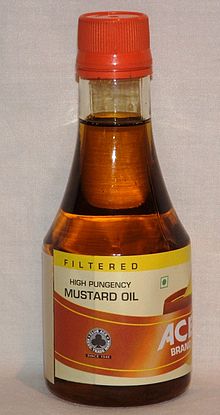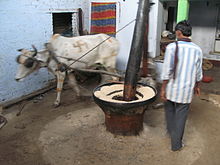- Mustard oil
-
The term mustard oil is used for three different oils that are made from mustard seeds:
- A fatty vegetable oil resulting from pressing the seeds,
- An essential oil resulting from grinding the seeds, mixing them with water, and extracting the resulting volatile oil by distillation.
- An oil made by infusing mustard seed extract into another vegetable oil, such as soybean oil
The pungency of mustard oil is due to the presence of allyl isothiocyanate, an activator of the TRPA1 channel.
Contents
Pure oil
This oil has a strong sinus-irritating aroma, like that of horseradish or wasabi, a hot nutty taste, and is often used for cooking in Northern India, eastern India, Nepal and Bangladesh. In north India, it is mainly used in frying fritters. In Nepal and Bengal, it is the traditionally preferred oil for cooking, although nowadays neutral-flavored oils like sunflower oil are also extensively used. The oil makes up about 30% of the mustard seeds. It can be produced from black mustard (Brassica nigra), brown Indian mustard (Brassica juncea), and white mustard (Brassica hirta).
Mustard oil contains the pungent Allyl isothiocyanate and has about 60% monounsaturated fatty acids of which 42% erucic acid and 12% oleic acid, it has 21% polyunsaturates of which 6% is the omega-3 alpha-linolenic acid and 15% omega-6 linoleic acid and it has 12% saturated fats.[1]
Mustard seeds, like all seeds of the Brassica family, including canola (rapeseed) and turnip, have high levels of omega-3 (6–11%) and are a common, cheap, mass-produced source of plant-based (therefore, vegetarian) omega-3 fatty acids (see Indo-Mediterranean diet in the links below). Flax (linseed) oil has 55% plant-based omega-3 but is uncommon as a table or cooking oil. Soybean oil has 6% omega-3 but contains over 50% omega-6, the fatty acid that competes with the omega-3 function. Other than rapeseed and mustard oils, there are few other common sources of plant based omega-3 in Western and Indian diets. Especially when omega-6 intake is kept low, humans can convert the plant omega-3 into one of the fish omega-3s, eicosapentaenoic acid, in limited amounts, a useful source for vegetarians.
In India, mustard oil is often heated almost to smoking before it is used for cooking; this may be an attempt to reduce the strong smell and taste. However, high heat can damage the omega-3 in the oil, reducing its unique role in health. In Western countries, the oil is often sold "for external use only" in stores catering to Indian immigrants, since in North India, mustard oil is also used for rub-downs and massages (see ayurveda), thought to improve blood circulation, muscular development and skin texture; the oil is also antibacterial. The oil is also sometimes used prior to sexual intercourse on the male genitalia to enhance erections or strengthen virility.[2]
Effects on health
The effects of erucic acid from edible oils on human health are controversial. However no negative health effects have ever been documented in humans.[3] A four-to-one mixture of erucic acid and oleic acid constitutes Lorenzo's oil; an experimental treatment for a rare neurobiology disorder adrenoleukodystrophy.
Mustard oil was once considered unsuitable for human consumption in the United States, Canada, and the European Union due to the high content of erucic acid. This is because of early studies in rats. Subsequent studies on rats have shown that they are less able to digest vegetable fats (whether they contain erucic acid or not) than humans and pigs.[4][5][6] Chariton et al. suggests that in rats: “Inefficient activation of erucic acid to erucyl-CoA and a low level of activity of triglyceride lipase and enzymes of betaoxidation for erucic acid probably contribute to the accumulation and retention of cardiac lipid.”[7] Before this process was fully understood it led to the belief that erucic acid and mustard oil were both highly toxic to humans.
Epidemiological studies[citation needed] suggest that, in regions where mustard oil is still used in a traditional manner, mustard oil may afford some protection against cardiovascular diseases. In this sense "traditional" means that the oil is used fresh and vegetable fats count only as a small percentage of the total caloric intake. Whether this effect is due to the nature of erucic acid per se to make the blood platelets less sticky, or to the presence of a reasonably high percentage of α-linolenic acid, or to a combination of properties of fresh unrefined oil, is as yet uncertain. Care needs to be taken with such epidemiological studies in order to exclude the possibility of early deaths from other causes skewing the results. The fact that early asymptomatic coronary disease is readily detectable post mortem and is absent in the mustard oil cohorts tends to add weight to the hypothesis that mustard oil is protective.[8]
The use of mustard oils in traditional societies for infant massage has been identified by one study as risking damaging skin integrity and permeability.[9] Other studies over larger samples have shown that massaging with mustard oil improved the weight, length, and midarm and midleg circumferences as compared to infants without massage, although sesame oil is a better candidate for this than mustard oil.[10]
Nutritional information
1tbsp of mustard oil contains the following nutritional information according to the USDA:[11]
- Calories : 124
- Fat: 14
- Carbohydrates: 0
- Fibers: 0
- Protein: 0
Solution
The pungency of the condiment mustard results when ground mustard seeds are mixed with water, vinegar, or other liquid (or even when chewed). Under these conditions, a chemical reaction between the enzyme myrosinase and a glucosinolate known as sinigrin from the seeds of black mustard (Brassica nigra) or brown Indian mustard (Brassica juncea) produces allyl isothiocyanate. By distillation one can produce a very sharp-tasting essential oil, sometimes called volatile oil of mustard, containing more than 92% allyl isothiocyanate. The pungency of allyl isothiocyanate is due to the activation of the TRPA1 ion channel in sensory neurons. White mustard (Brassica hirta) does not yield allyl isothiocyanate, but a different and milder isothiocyanate.[12]
Allyl isothiocyanate serves the plant as a defense against herbivores. Since it is harmful to the plant itself, it is stored in the harmless form of a glucosinolate, separate from the myrosinase enzyme. Once the herbivore chews the plant, the noxious allyl isothiocyanate is produced. Allyl isothiocyanate is also responsible for the pungent taste of horseradish and wasabi. It can be produced synthetically, sometimes known as synthetic mustard oil.[13]
Because of the contained allyl isothiocyanate, this type of mustard oil is toxic and irritates the skin and mucous membranes. In very small amounts, it is often used by the food industry for flavoring. In northern Italy, for instance, it is used in the fruit condiment called mostarda. It is also used to repel cats and dogs. It will also denature alcohol, making it unfit for human consumption, thus avoiding the taxes collected on alcoholic beverages.[citation needed]
The CAS number of this type of mustard oil is 8007-40-7, and the CAS number of pure allyl isothiocyanate is 57-06-7.
Use in North Indian cultural and artistic activities
Mustard oil was once popular as a cooking oil in northern India. In the second half of the 20th century the popularity of mustard oil receded due to the availability of mass-produced vegetable oils. It is still intricately embedded in the culture:
- It is poured on both sides of the threshold when someone important comes home for the first time (e.g. a newly-wedded couple or a son or daughter when returning after a long absence, or succeeding in exams or an election.
- Used as traditional jaggo pot fuel in Punjabi weddings.
- Used as part of home-made cosmetics during mayian.
- Used as fuel for lighting earthen lamps (diyas) on festive occasions such as Diwali.
- Used in hair. Known to be extremely beneficial for hair growth[citation needed].
- Used in instruments. The residue cake from the mustard oil pressing is mixed with sand, mustard oil and (sometimes) tar. The resulting sticky mixture is then smeared on the inside of Dholak and Dholki membranes to add weight (from underneath) the bass membrane.This enables the typical Indian drum glissando sound, created by rubbing one's wrist over it. This is also known as a (Tel masala) Dholak Masala or oil syahi.
References
- ^ Entry for mustard oil in the USDA National Nutrient Database for Standard Reference, Release 22
- ^ http://www.popcouncil.org/pdfs/ebert/culturenorms.pdf
- ^ Food Standards Australia New Zealand (June 2003) Erucic acid in food : A Toxicological Review and Risk Assessment . Technical report series No. 21; Page 4 paragraph 1; ISBN 0 642 34526 0, ISSN 1448-3017
- ^ Hulan HW, Kramer JK, Mahadevan S, Sauer FD (January 1976). "Relationship between erucic acid and myocardial changes in male rats". Lipids 11 (1): 9–15. doi:10.1007/BF02532578. PMID 1250074.
- ^ Kramer JK, Farnworth ER, Thompson BK, Corner AH, Trenholm HL (May 1982). "Reduction of myocardial necrosis in male albino rats by manipulation of dietary fatty acid levels". Lipids 17 (5): 372–82. doi:10.1007/BF02535197. PMID 7098776.
- ^ de Wildt DJ, Speijers GJ (June 1984). "Influence of dietary rapeseed oil and erucic acid upon myocardial performance and hemodynamics in rats". Toxicol. Appl. Pharmacol. 74 (1): 99–108. doi:10.1016/0041-008X(84)90275-8. PMID 6729825. http://linkinghub.elsevier.com/retrieve/pii/0041-008X(84)90275-8.
- ^ Charlton KM, Corner AH, Davey K, Kramer JK, Mahadevan S, Sauer FD (July 1975). "Cardiac lesions in rats fed rapeseed oils". Can. J. Comp. Med. 39 (3): 261–9. PMC 1277456. PMID 1170010. http://www.pubmedcentral.nih.gov/articlerender.fcgi?tool=pmcentrez&artid=1277456.
- ^ Rastogi T, Reddy KS, Vaz M, et al. (April 2004). "Diet and risk of ischemic heart disease in India". Am. J. Clin. Nutr. 79 (4): 582–92. PMID 15051601. http://www.ajcn.org/cgi/content/full/79/4/582.
- ^ Darmstadt GL, Mao-Qiang M, Chi E, Saha SK, Ziboh VA, Black RE, Santosham M, Elias PM. (2002). Impact of topical oils on the skin barrier: possible implications for neonatal health in developing countries. Acta Paediatr. 91(5):546-54. PMID 12113324
- ^ Effects of massage & use of oil on growth, blood flow & sleep pattern in infants,Agarwal KN, Gupta A, Pushkarna R, Bhargava SK, Faridi MM, Prabhu MK,Indian J Med Res. 2000 Dec;112:212-7, PMID 11247199
- ^ http://www.nal.usda.gov/fnic/foodcomp/search/
- ^ "Mustard". A Guide to Medicinal and Aromatic Plants. Center for New Crops and Plant Products, Purdue University. http://www.hort.purdue.edu/newcrop/med-aro/factsheets/MUSTARD.html. Retrieved 3 January 2009.
- ^ "Mustard Oil, Synthetic". JT Baker. http://hazard.com/msds/mf/baker/baker/files/p3225.htm. Retrieved 3 March 2010.
External links
- Effect of an Indo-Mediterranean diet on progression of coronary artery disease in high risk patients (Indo-Mediterranean Diet Heart Study) a randomised single-blind trial.
- Isolation of Erucic Acid from Mustard Seed Oil by Candida rugosa lipase
- Tanuja Rastogi; Reddy, KS; Vaz, M; Spiegelman, D; Prabhakaran, D; Willett, WC; Stampfer, MJ; Ascherio, A (2004). "Diet and risk of ischemic heart disease in India". American Journal of Clinical Nutrition 79 (4): 582–592. PMID 15051601.
Edible fats and oils Fats Bacon fat · Blubber · Butter · Clarified butter · Cocoa butter · Dripping · Duck fat · Ghee · Lard · Margarine · Niter kibbeh · Salo · Schmaltz · Shea butter · Smen · Suet · Tallow · Vegetable shorteningOils Almond oil · Argan oil · Avocado oil · Canola oil · Cashew oil · Castor oil · Coconut oil · Colza oil · Corn oil · Cottonseed oil · Fish oil · Grape seed oil · Hazelnut oil · Hemp oil · Linseed oil (flaxseed oil) · Macadamia oil · Marula oil · Mongongo nut oil · Mustard oil · Olive oil · Palm oil (palm kernel oil) · Peanut oil · Pecan oil · Perilla oil · Pine nut oil · Pistachio oil · Poppyseed oil · Pumpkin seed oil · Rapeseed oil · Rice bran oil · Safflower oil · Sesame oil · Soybean oil · Sunflower oil · Tea seed oil · Walnut oil · Watermelon seed oilCategories:- Cooking oils
- Vegetable oils
- Essential oils
Wikimedia Foundation. 2010.


